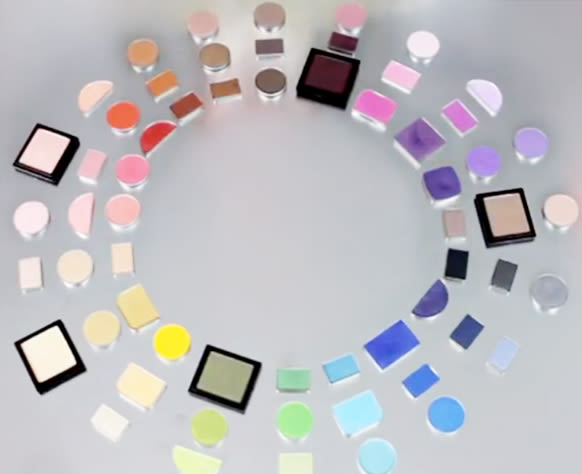Do you ever find yourself thinking, “Man, I just wish those little green flecks in my brown eyes would stand out more!” but you’re not quite ready to go full tilt with tinted contacts? Or perhaps your blush is looking way harsh and you don’t know where to go next. Or, maybe, you’re fed up with not knowing what kind of red lipstick (blue-tinted? orange?) is right for your skin tone. Well, we’ve got some answers, courtesy of Robert Jones, a makeup artist and former art student who gives an in-depth lesson on the color wheel and how it relates to makeup. It's our slightly academic, but really informative how-to video of the week!
The Color Wheel (0:00 – 3:00)
First and foremost, you need to reacquaint yourself with the color wheel—you know, that little rainbow circle that hung in every art classroom of your educational career. Remember when you first learned how to mix red and blue to make purple? That’s what Jones will re-teach you. If you’ve dabbled in the arts and are already familiar with the color chart, go ahead and skip to just before the three-minute mark, where he starts to talk about…
Eye Shadow (3:00 – 8:00)
Here, it’s all about “complimentary colors.” In place of wearing a shadow that matches your iris, it’s best to look directly across the color wheel to achieve a real boost in eye tone. For instance, if you have blue eyes, blue eyeshadow isn’t going to do much to help those peepers pop, but bronzes, coppers, and other warm hues will really pump up your natural sapphire.
Blush (8:00 – 12:35)
Key words of wisdom: “[Blush is] not to contour your face with. It’s not to reshape your face. It’s to add life and color to your face.” Jones’ rule of thumb? Don’t use a blush darker than your own natural flush. Where blushes are concerned, skin tones fall into one of two categories: ivory-beige or bronze-ebony. While some blushes can work with either side of the spectrum, lighter, ashier shades should be reserved for those with ivory-beige faces, while darker, richer, warmer blushes will benefit darker skin tones.
Lipstick (12:35 – end)
The most important factor when deciding on lipstick is lip size. Though we’re the first to tell you to bend the rules in this department, generally speaking, the darker the lipstick color, the smaller your lips will appear. So if you’re sporting a microscopic mouth and are looking for natural enhancement, Jones suggests sticking with a light color. Now you know!
In the end, makeup color theory is all about intensifying your best features. While Jones lays out some hard-and-fast suggestions, they’re just that (suggestions). If you find that an emerald eyeshadow makes your hazel eyes worthy of becoming the subject of a Coldplay song, live your dreams. If your little lips look luscious in a deep oxblood stain, go and smear it on that sucker. You do you and hopefully Robert Jones will help that you get just a smidge better and brighter.

